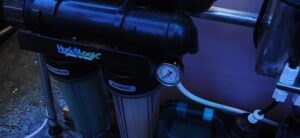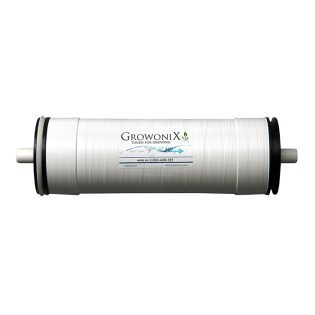
If you’re unsure how often to change reverse osmosis filters or dechlorinator filters, then our RO filter replacement guide is a must-read - the quality & health of your plants depends on it!
Don’t risk your old, tainted water filters or membranes letting contaminants through - you paid good money for your water filtration system, so you might as well make sure it’s running smoothly at all times and doing its job!
The problem is that aside from commercial water filtration systems, there is usually no onboard indicator of when exactly it’s time to start replacing RO filters.
Your manufacturer may have provided an estimation, but because every feed water quality & conditions are different, you need a more accurate way to tell when it’s time to swap that old filter out.
And that’s what we’re going to do today - we'll explain the foolproof way to determine if its time to change your RO membrane, your pre-filters, and your carbon filters. Let’s start with the importance of water filter replacement.
TL;DR: RO membranes need to be replaced every six months, and other filter types will need to be changed once a year. But the only way to know for sure if it's time to replace your filter or membrane is by testing the filtered water and looking for a drop in efficiency or efficacy.
Is Dechlorinator & RO Filter Replacement Even Important?
This may sound obvious, but yes - dechlorinator & RO filter replacement is important! Just like the carbon filter in your grow tent or air filter in your car/home, these filters & membranes don’t last forever.

They work super hard to trap contaminants and prevent them from getting through to your plants - over time, the membrane is going to become clogged and inefficient. Or worse - it will start deteriorating, and allow solids to pass through into your reservoir that feeds your plants.
At this point, you might as well be feeding your plants directly from the tap - your expensive water filter isn't even doing what it's supposed to!
Keeping up on proper RO filter replacement is important not just to keep your plants healthy, but to protect the life of your filtration system itself. These same compounds & contaminants may be detrimental to your dechlorinator or RO filter.
The Different Types Of Filters You'll Need To Replace
Whether you're growing using an RO filter or a dechlorinator & sediment filter, one thing is certain - you're going to have to replace more than just one component.
Dechlorinators usually only have two aspects that need replacing - the sediment pre-filter and the carbon filter. RO filters, on the other hand, feature an additional stage of filtration - they also include an RO membrane that will need to be replaced on a pretty frequent schedule - as soon as every 4-6 months, depending on how you use it.
While dechlorinators last a bit longer than RO filters, they don't produce the same quality water. These only remove chloramines and heavy solids, whereas an RO filter will remove these along with any chemicals or compounds - getting you as close as possible to 0 PPM water.
Both of these types of filters tend to have multiple membranes that need to be replaced, so be sure to replace all necessary components - not just the RO membrane, or the carbon filter, or the sediment filter. While all of these will likely have different timelines for when they need to be replaced, it's important that you ultimately do remember to change them all.
How Often To Change Reverse Osmosis Filters For Horticulture
Ok, so obviously dechlorinator & RO filter replacements matter - but what is the recommended RO replacement filter frequency?
As you can imagine, there isn’t a one size fits all answer to this question. Obviously it varies from specific filter to filter - in terms of manufacturer and filter type (more on this later) - but the biggest reason is varying feed sources.
How Hard Does Your Filter Have To Work?
The biggest reason for the variance in how often to change reverse osmosis filters is because everyone has different tap waters with different PPM’s.
If you have relatively clean water, you obviously aren’t forcing your filter to work as hard. This means you’ll get a longer lifespan out of each replacement membrane you buy.
On the other hand, some cities have disgusting tap water - and if this sounds like the conditions in your area, you’ll be disappointed to learn that you’ll have to replace your water filter more frequently. That membrane will clog and become ineffective far sooner than the other one, even when running the same duration.
This is why it’s important for you to understand what’s in your local tap water - so do your research!
You can also test your tap water yourself for a more accurate look into the water quality in your specific home or facility.
Recommendations Vary From Brand To Brand (And Model To Model)
Another factor that you need to consider is what specific brand your water filter is, and the specific model you’re using.
A standard RO filter by GrowoniX and a standard RO filter by HydroLogic have different guidelines.
Furthermore, you may not need to replace your RO filter as quickly if you’re using a more premium membrane. These include products such as coconut, KDF, or a catalytic carbon filter.
General Guidelines For How Often To Change Reverse Osmosis Filters
Fortunately, we’ve compiled information on the most common RO filters to help you understand when it’s time to order your RO filter replacements.

We’re going to provide detailed insights into not only when it's time to start considering replacing RO filters, but the specific part number you need to replace it with, along with all the specifications you should consider!
These will serve as excellent guidelines, meaning you should still do your due diligence to test the PPM of your filtered water around the time your filter could start to lose it’s efficiency. IF you notice PPMs are rising, it’s time to replace your filter.
We’re going to start with guidelines on how often to change Hydrologic RO filters
Guidelines For HydroLogic Water Filters
Most of the HydroLogic RO filters include either the standard green coconut carbon filter membrane or the upgraded, premium KDF/CAT carbon filter. These are rated for around 1,000 or 2,000 gallons of filtered water respectively.
If you’re using a dechlorinator by HydroLogic instead of an RO filter, then you won’t enjoy the same reductions in PPM - but your membrane will last longer, with the standard filter rated at 3,000 gallons of clean water or the premium upgrade KDF/CAT carbon filter rated at twice as much, 6,000 gallons.
To be certain about when it's time to replace your water filter, though, review this HydroLogic Filter Replacement PDF.
Guidelines For GrowoniX Water Filters
The other major brand we carry here at Hydrobuilder is GrowoniX - these guys manufacture incredibly high quality, efficient RO filters & dechlorinators as well.
You can still choose between a standard carbon filter or an upgraded KDF/CAT filter, but these guys don’t have a handy chart showing recommended filter changeout timeframes.
Instead, they recommend you closely monitor TSD or RO filter efficiency and use these as your guide for when it’s time to change the membrane.
They say on average, this will be around once a year or every 2,500 gallons - whichever comes first. Keep in mind that this estimation varies based on how dirty your water is.
How To Extend The Life Of Your RO Filter

Now that you know how often to change reverse osmosis filters, let’s talk about how you can extend the life of yours and decrease the frequency at which you need to replace it.
One thing you can look at is the type of filter you have, and consider upgrading if possible. Like we said earlier, premium filters last longer than others. Compare the following Hydro-Logic replacement filters:
- Stealth-RO Coconut Carbon Filter: 1,250 gallons
- Stealth-RO KDF/CAT Carbon Filter: 2,000 gallons
As you can see, upgrading to the premium replacement filters will help you kick the can further down the road before you need to replace it again - an additional 750 gallons of clean water. It’s always worth upgrading when it comes to your water source!
Another thing you can do is regularly flush your membranes. This is much easier if your water filter includes a flush valve, like GrowoniX does. Flushing will extend the life of your membrane considerably.
Of course, don't forget to regularly clean your prefilter. These prefilters don't need to be changed as frequently provided you routinely clean them. This will also ensure your carbon filter and RO membrane don't have to work as hard.
Final Thoughts On RO Filter Replacement Frequency & Best Practices
We hope our RO filter replacement guide helped you gain a better understanding of how often to change reverse osmosis filters. It’s not a super clear topic, and there is really no way for us to give you an exact answer without knowing the exact filtration system you're using and the quality of your feed water.
So in closing - we want to encourage you to constantly monitor your TDS or PPM levels of the water you’re filtering. As your clean water efficiency falls, and TDS/PPM rises - you’ll know for sure it’s time to replace your filter. In general, though - RO membranes need to be replaced every six months, and other filter types will need to be changed once a year.
Even if you don’t suspect needing to replace your RO filter for another few months, it’s a good idea to grab yours now and make sure you have it on hand for when the time comes. Quality water is not something your plants can go without!



















